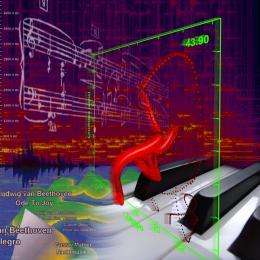Intelligent DJ Emerges from Fundamental Research

(PhysOrg.com) -- An Austrian project has made the leap from research bench to shop shelf and is breathing musical intelligence into a digital audio system. This achievement has been made possible by a computer algorithm that is the first to enable the automatic creation of customised playlists directly in a hi-fi. The algorithm identifies specific musical characteristics such as rhythm and compares stored audio files for similarities. The know-how behind this system was developed some time ago with support from the FWF - and is now being used in a new music system from Bang & Olufsen.
Endless musical enjoyment to your own individual taste and no need to create a playlist - it sounds like the music of the future. But it is not - a new computer algorithm has made all this possible here and now. The scientific know-how behind the development has been provided by Prof. Gerhard Widmer, Head of the Institute for Computational Perception at Johannes Kepler University Linz and Member of the Scientific Board of the Austrian Research Institute for Artificial Intelligence (OFAI) in Vienna. Several years ago, Prof. Widmer and his team realised that the rapid growth in the use of digital music files was producing a need for new computer methods. And one result of his research work is now available in all good music stores and is at the heart of the BeoSound 5 digital audio system from Bang & Olufsen - the MOTS computer algorithm.
MOTS operates like a personal DJ and demonstrates impressive musical intelligence. The algorithm analyzes audio files, extracting "features" that it then uses to calculate the similarities between various pieces of music. Depending on the audio file selected, MOTS automatically searches out similar files and does its name justice - it tracks down More Of The Same.
"Algo-Rhythm"
In order that MOTS can assess the similarity of pieces of music, the tracks need to be translated into mathematics. To do this, features that characterise a piece of music are calculated from its audio signal. This characterisation process takes into account rhythm, "sound" (i.e. frequency patterns, tone colour, etc.) and other aspects that are central to the human perception of music. These features are then turned into statistical models that represent the piece of music while being far more compact than the original audio file. Project Manager Prof. Widmer explains: "The model for a 40-megabyte music file amounts to a size of just 800 numbers, or 3 kilobytes. MOTS uses this compressed information to compare various songs. This is essential for calculating similarities."
MOTS uses statistical methods to decide which piece is the most similar to another - but doesn't just do so in an experimental setting. MOTS is the core technology in the first stereo system to offer musical intelligence and is exceptionally user friendly. The system, which creates intelligent playlists that are customised for the individual user, is compatible with all current formats such as MP3, WMA and AAC.
Fundamental Research that Rocks
The first step in the development of MOTS was taken as early as 1998, when Gerhard Widmer, who was 37 years old at the time, won the prestigious START Prize for exceptional young scientists. Years later, the FWF supported Prof. Widmer's work as part of a translational research project aimed at further developing the application aspects of his fundamental research. The WWTF (Vienna Science and Technology Fund) also contributed to the success of the project. Prof. Widmer on the support his project received: "I think that the development of MOTS is a fantastic example of how the promotion of fundamental research can help produce extremely exciting applications in a relatively short space of time."
However, this success is not the end of the road for Prof. Widmer and his team. Further ambitious goals that the research team is working towards include the visualisation of large music collections, computer models of expression in music, the automatic retrieval of music-relevant information from the Internet, and computers that can follow music in real time. There is no doubt that the future will bring new technologies that will make digital music a great deal easier to manage - also thanks to the support of the FWF.
Provided by Austrian Science Fund

















